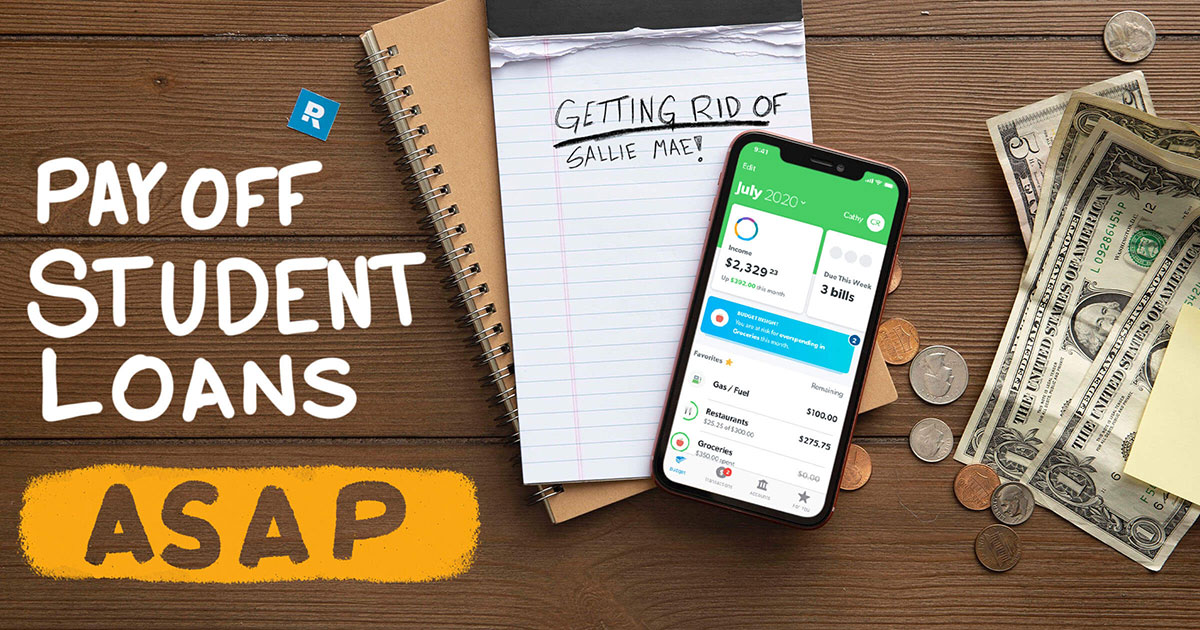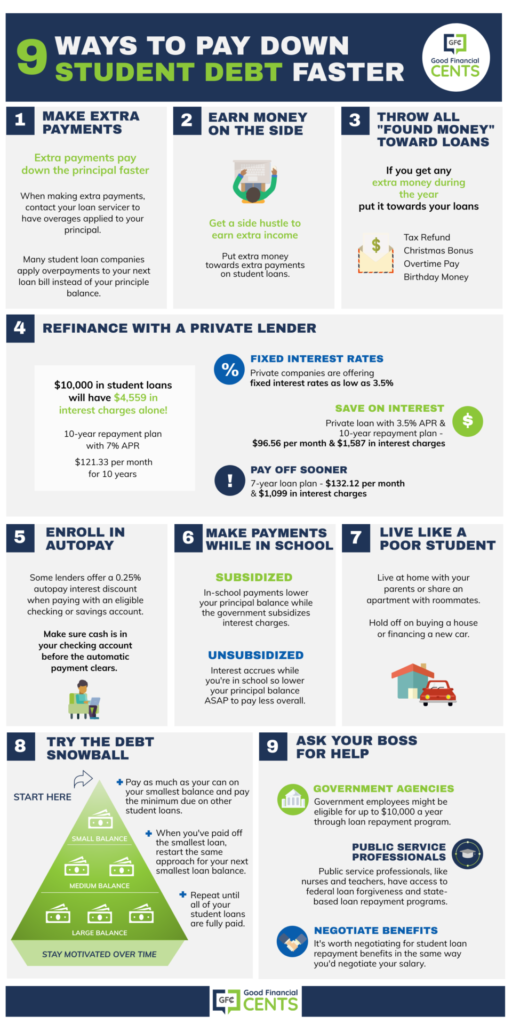Last Updated on January 15, 2023
How To Repay Student Loans Faster
Student loans can be a huge burden to bear, but there are ways to get out from under them sooner. Here are some tips for repaying student loans faster:
- Make extra payments whenever possible.
- Find ways to reduce your expenses so that you have more money to put towards your debt while you’re still in school and making less money than you will once you’ve graduated.
- Don’t forget about interest rates! If you have a credit card with an interest rate lower than the rate of your student loan, it makes sense to pay off that credit card first—even if it takes longer—because then your payments will go towards paying down the principal amount of your debt instead of just paying interest on top of it indefinitely until the entire balance has been paid off (which could take years).
How To Repay Student Loans Faster
How to Pay Off Student Loans in 10 Steps
- Get on a budget.
- Find out your payoff date.
- Pay more than the minimum payment.
- Make some financial sacrifices.
- Pay off student loans with the debt snowball.
- Apply every raise and tax refund toward paying off your student loans.
- Increase your income with a side hustle.
- Don’t bank on student loan forgiveness.
- Refinance student loans—if it makes sense.
- Stay motivated and you’ll destroy your student loan debt ASAP!
1. Get on a budget.
Find out if you qualify to refinance your student loan and get rid of debt faster.
When you stick to a budget, you might even find “extra” money you didn’t know you had, which is a way better plan than hoping to find $10 in your old windbreaker jacket from high school. Once you start throwing all that extra money at your student loans each month, you’ll start making progress in no time!
The easiest way to budget is with our free budgeting app, EveryDollar. You can even put a line item in your budget for each student loan you’re paying off. That way you’ll see the progress as you keep crushing that student loan debt—and it’ll feel pretty sweet.
2. Find out your payoff date.
Check out our Student Loan Payoff Calculator, where you can enter in your monthly payment, loan balance and interest rate for each student loan you’ve got. You’ll see the date you’ll pay off each loan if you keep making those minimum payments. You might not like what you see at first, but don’t worry. Move straight to point #3 to see what happens if you get focused on paying more than the minimum.

3. Pay more than the minimum payment.
You’ve probably heard this one before. If you’re only paying the minimum payment each month, you’re not getting anywhere fast. You might not even be breaking even with the interest you’re piling up! By making larger payments, you’ll be able to attack the amount you owe at a quicker rate. Start playing around with that Student Loan Payoff Calculator to figure out how fast you can pay off your loans by making extra payments.
Here’s an example:
- Let’s say you have the typical amount of student loan debt that the average student graduates with, which is $38,792.1 (That number could be made up of multiple loans, but for the sake of this example, we’ll say it‘s all one loan.)
- With a 5.8% interest rate (which is the industry average) and a 10-year loan term (which is super common), you’d be looking at a minimum monthly payment of $426.78.2
- Because of interest, your total repayment amount would be $51,489—that’s $12,697 more than your original loan! Yikes. That blows.
- But let’s say you decided to pay just 20% more than your minimum payment each month (that’s $85.36). That would put your monthly payment at $512.14—which means you’d pay off your entire loan in about eight years and save $2,794.04 in interest (plus over two years of your life)! That’s more like it.
- If you paid over 20% more than your minimum payment each month, you’d pay off your loan even faster (I like that plan even better). You get the picture!
A word to the wise, though: When you pay more than the minimum monthly payment, the student loan servicers might put that extra amount onto next month’s payment. That pushes the due date back, but you won’t actually pay off your loan any faster. Tell your loan servicer to keep next month’s due date the same and to just apply the extra amount of money to your current loan balance.
Maybe you’ve heard about biweekly payments, where you make two payments per month. I’d only suggest setting this up if you’ve got just one loan you’re paying down, and the double payments are motivating you to work way harder to pay it off. Otherwise, I want you knocking out each loan one at a time, smallest to largest, in what’s called the debt snowball method. (I’ll cover that more in point #5.)
All that said, if you’re having trouble even making the minimum payment each month, you might think the idea of paying more money is a pipe dream. With that in mind . . .
4. Make some financial sacrifices.
Remember when I brought up sacrifice earlier? Like saying no to late-night fast food? Here’s where it comes into play.
Look at your lifestyle. What extra stuff have you been living with that you can do without? Bye bye, cable package. See ya, bougie subscription boxes. Maybe cut your housing cost in half by finding a roommate. Do you have a guest room that’s not getting much use these days? Rent that sucker out! Just think how quickly you could pay off your loans if your housing costs were cut way down.
How about selling some junk you don’t need anymore? Dig through your closet, garage and storage to see what you could put on eBay, Facebook Marketplace or Craigslist. Then, add up what you spend eating out every week. Ditch the $7 oat milk lattes and brew your own coffee at home. Eat your leftovers (they’re not that bad) or meal prep for the week instead of spending $10–20 on lunch. Get savvy at the grocery store. Trust me—there are plenty of creative ways to save. But it starts with being willing to make some temporary sacrifices for some long-term gains.
5. Pay off student loans with the debt snowball.
The debt snowball method has helped a ton of people dump their debt, and it can work for student loans too. First, list all your loan debts (private loans, secured loans, unsecured loans—you name it) from smallest balance to largest. Start paying on the smallest student loan balance first. Throw any extra money you have into paying off that first debt while still paying the minimums on everything else.
Once you’ve paid off the first debt, move to the second-smallest balance. Take everything you were putting toward the first one and add it to the minimum of the second balance. Once that debt is paid, move on to the next one and repeat the process until you’re finally out of debt. Boom.
You might be thinking, Nope—this is going to take forever! Don’t get it twisted. Most people that go all in on this plan pay off their debt in 18 to 24 months! That’s not quite forever, is it? My favorite thing about working the debt snowball method is that you’ll feel the progress you’re making as each student loan disappears. Knocking those smaller loans out first will give you a couple of quick wins and help you stay motivated to crush the bigger student loans fast!
Just make sure you don’t pocket the extra payment money as you pay off each loan. Keep the momentum going by rolling that money into the next loan payment.
Pro tip: Don’t do this on your own. Take a class like Financial Peace University (FPU) and learn how to work the plan that’s changed almost 10 million lives. This plan will help you stay on the debt-free grind and get rid of your debt as fast as humanly possible. You can get FPU today (and the premium version of the EveryDollar app I mentioned earlier) with a free trial of Ramsey+.
6. Apply every raise and tax refund toward paying off your student loans.
What do most people do when they get a raise? They blow through it like it’s nothing. And then they wonder why it felt like they didn’t get a raise.
As you keep growing in your career and getting promotions as you go, put your extra income toward paying off those student loans. Don’t move to a bigger house. Don’t buy a new car. Don’t buy any designer threads. And don’t upgrade your smartphone. You were living without that extra money before, and you can keep living without it a little while longer. Now is not the time to upgrade your lifestyle. You can do that later when you don’t have a payment in the world! Use your income boost to make major progress in your fight against student loan debt.
The same goes for your tax refund. How many people do you know who take that “free money” and burn it all on new furniture, clothes or a 55-inch flat-screen TV? One extra deposit into the bank account, and suddenly a little voice in your head yells, Treat yourself!
Here’s a not-so-fun fact: Your tax refund isn’t free money from the government. They’re just giving you back your own money because you paid them too much. They were just holding onto your money all year long with zero percent interest earned! If you really want to treat yourself, take that refund and put it directly toward paying off a big chunk of your student loans!
7. Increase your income with a side hustle.
If your biggest problem is income, pick up a part-time job on the nights or weekends so you can stack cash quickly. Then toss that extra cash directly at your student loan debt! There are a ton of side hustle options out there—everything from driving an Uber and delivering food to walking dogs and house-sitting. When I was paying off my student loans, I drove for Lyft and Uber and did freelance marketing work to pay those bad boys off even faster.
And don’t hit me with the “I don’t have time for another job” excuse. If you have time to hang out with your friends, scroll Instagram, or watch Netflix, you have time to make a few extra bucks.
Remember, the extra job won’t last forever. You’re just trying to get intense and kick that student loan debt out of your life so you can move on with your life.
8. Don’t bank on student loan forgiveness.
Okay, this one really grinds my little gears. I know people probably told you that taking out student loans was no big deal because you could just get them forgiven later.
But student loan forgiveness isn’t really the dream come true it sounds like. First off, with the current program, there are so many requirements you have to meet in order to be eligible (like working in a public service job for 10 years). And even then, forgiveness isn’t guaranteed.
Now, there’s been a lot more talk lately about the government wiping out student loan debt across the board. Okay, that would be awesome, but don’t bank on it. I mean, Biden talked a lot about that sweet student loan forgiveness. So far, he’s canceled nearly $3 billion of current student loans.3 That may sound like a lot until you hear the current federal student loan debt sits at $1.57 trillion (as of summer 2021).4 So after all that talk, only 0.19% of the debt was forgiven. Listen: Politicians make a lot of empty promises. It doesn’t matter who’s in the White House. You’re responsible for taking care of your money and your debts.
You’re better off having a job that pays well (that you actually like) so you can go ahead and pay off your student loans as fast as you can. That way you won’t spend years of your life waiting to have your loans forgiven—it may never happen.
P.S. If you’re into documentaries, you need to check out this new one called Borrowed Future—it’s all about the student loan debt crisis in America. But be forewarned: it might make you a little mad. Borrowed Future premieres October 14 on Amazon Prime Video, AppleTV or Google Play.
9. Refinance student loans—if it makes sense.
Before you go running into the arms of an all-too-eager lender, know that refinancing student loans is not the right move for everyone. If someone told you this is the absolute best way to pay off student loans, they were lying. But that doesn’t mean you shouldn’t at least look into refinancing.
When you refinance, you’re taking all your loans—federal, private, often a mix of both—to a lender who pays them off for you. And now you owe this new lender the money they just fronted you.
With a refinance, the goal is to secure a better rate and better payment terms—which means you pay less each month and for a shorter amount of time to one lender instead of more money for a longer period of time to one or more lenders.
If you’re in a position to keep paying the same amount you were paying before you refinanced, even better. Because that means you’re throwing more at the principal each month than you were before and avoiding more interest. Plus—and here’s the best part—if you’ve got other debt outside your newly refinanced student loan, you can ramp up your debt snowball even faster once you knock out that student loan. (Head back to #5 for a debt snowball crash course!)
Remember though, you’re refinancing to get a better rate and payment terms. If that’s not what you’re being offered, don’t refinance. It’s a bad deal. Make sure to do your homework and read the fine print, or you could end up deeper in the hole than you were before.
10. Stay motivated and you’ll destroy your student loan debt ASAP!
Look, I’m not here to beat you up because you took out student loans in the past. I ain’t no bully. But I do want you to experience the power of living debt-free. There’s no need to drag out your student loan payments for the next five, 10 or even 20 years. When your money doesn’t have Sallie Mae’s name on it every month, you can do so much more with it. Just think about how many Beefy Fritos Burritos that freed up money could buy!
If you’re ready to kick-start your journey to dumping student loan debt, then start with our 64-page quick read, Destroy Your Student Loan Debt: The Step-by-Step Plan to Pay Off Your Student Loans Faster. Then jump into that free trial to Ramsey+, your membership to the content that walks you through your debt-free journey and the tools you need to make it happen.
Remember, the only magic in this is you and how hard you’re willing to work. But it’s totally worth it. You’re worth it. Keep fighting the good fight (and the bad debt!).
how to pay student loans
7 TIPS FOR HOW TO PAY OFF STUDENT LOANS

Creating a plan to repay your student loans can help you get out of debt faster and borrow less in the long run.Higher education can be costly. Credit.com states the average student has roughly $31,000 in debt after graduation. It is important to determine how much student debt you have prior to graduation. It can help you better understand the type of repayment plan you need to have. Below are 7 ways to start paying off your student loans, even while you are still in college.
1. UNDERSTAND HOW YOUR STUDENT LOAN DEBT WILL AFFECT YOUR FUTURE
If you haven’t started repaying your college loans yet, it can be hard to imagine how they could impact your income and lifestyle. Are you going to be able to make enough money to cover your loan payments and support everyday living expenses?
You’ll get some ideas about repaying your student loans by looking at a student loan repayment calculator like 1st Financial Bank USA’s Student Loan Repayment and Affordability Calculator. Student loan repayment calculators show your estimated loan payments based on your interest rate and term length of the loan. These calculators help you determine how much of your future salary will go toward your loan payments, and can give you an excellent reality check, preventing you from over-borrowing in college.

2. START MAKING STUDENT LOAN PAYMENTS WHILE YOU’RE STILL IN SCHOOL
It may sound impossible to make loan payments while you’re still a college student and not earning a significant income. However, any amount you can put toward your student loans will reduce your debt and help you form responsible saving habits in the long run. If you don’t have other necessary expenses to pay for, use money you earn from a part-time job or other odd jobs to start paying off your debt.
Federal unsubsidized loans and private loans accrue interest during college that will be added to your total loan balance. If you start paying down this interest as soon as possible, it can result in lower debt after graduation.
3. RETURN YOUR FINANCIAL AID REFUNDS
After your school receives your college loan disbursement from your lender, it will deduct tuition, fees, and other costs from your total bill. Then the remainder of the loan will be refunded to you. Your return can be used for expenses not billed by the university, such as off-campus rent, books, and supplies, if needed.
If you have money left over after covering these expenses, it can be tempting to spend it. Once you’ve spent your leftover money from the loan, you’ll have to pay it back with interest. Instead, return the refund to the lender within their specified time period (usually from 30-120 days) so you stay on track.
4. PAY DOWN HIGH AND VARIABLE INTEREST LOANS FIRST
It can be easier and faster to pay off student loans if you make more than the minimum payment each month. If you have multiple college loans with different interest rates, some financial experts suggest paying more than the minimum payment on your highest and variable interest rate loans and making the minimum payment on loans with lower, fixed interest. This strategy can help eliminate or reduce your most expensive college loans faster and protect you from variable interest rates that can raise your monthly payments.

5. WORK AND SAVE DURING THE “GRACE PERIOD”
Federal college loans don’t require students to start making payments until six months after graduation. This time frame is known as a “grace period.” Save as much money as you can during your grace period to put toward your loans, especially if you land a job right out of college.
6. SET UP AUTO-PAY
Having your student loan payments automatically deducted from your bank account will prevent you from missing payments and incurring late fees. Even better, some loan servicers offer an interest rate deduction if you sign up for auto-pay. Federal student loans, for example, offer a 0.25% interest rate deduction.
7. CHOOSE THE RIGHT STUDENT LOAN REPAYMENT PLAN
Look at all the repayment plans available and choose one that works best for your financial goals. Federal college loans offer several repayment options:
- The standard repayment plan sets up the same payment amount every month (with a minimum payment of $50). Unless you have decided to have a different plan, this standard plan is the one you will receive. Students on this plan must pay off their loan in 10 years.
- The graduated plan increases your payments every two years. Students must repay this loan within 10 years.
- The extended plan sets up either a fixed or graduated payment over a period of 25 years.
- The five income-driven plans allow payments to fluctuate according to your annual income, family size, and other factors. For example, the Revised Pay-as-You-Earn plan reduces monthly loan payments to 10 percent of discretionary income and forgives the remaining loan balance after 20-25 years of consistent payments.
You can switch to a different payment plan anytime with no penalty. Just keep in mind that a plan with a lower monthly payment will take longer to pay off, and you’ll pay more in interest.
Repaying college loans can be a complicated process. It’s important to understand that paying for college takes consistency and financial stability, and finding the right repayment plan is going to make a big difference. While you’re still in school, try to save as much as possible or start repaying your loans so you have less to pay off later.

